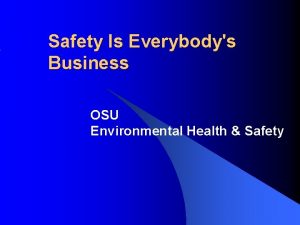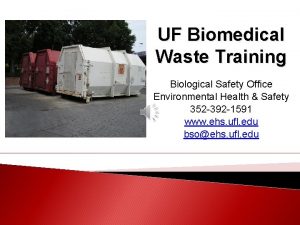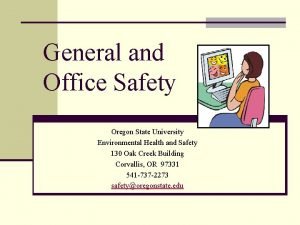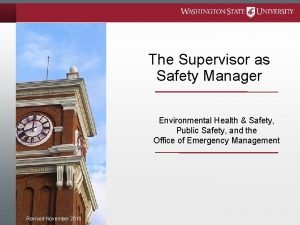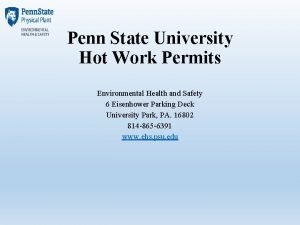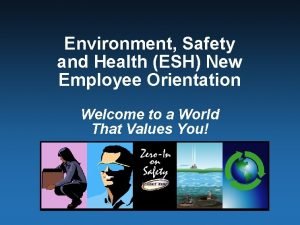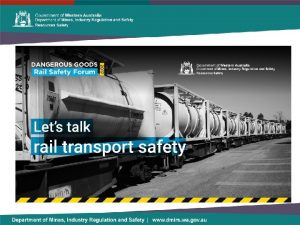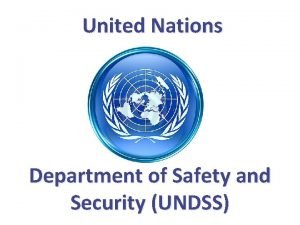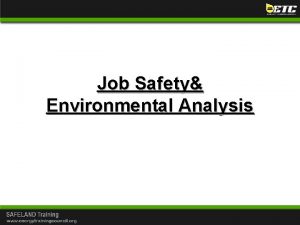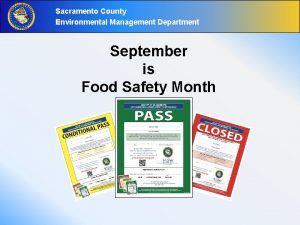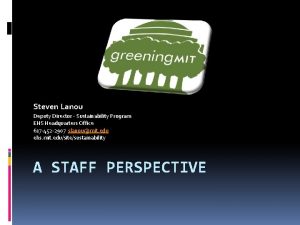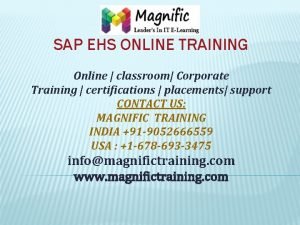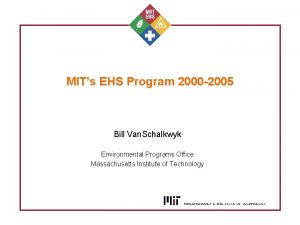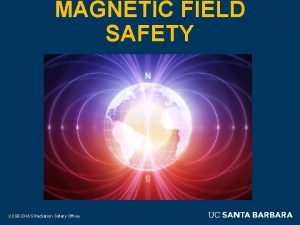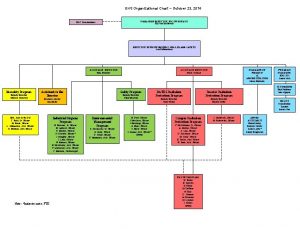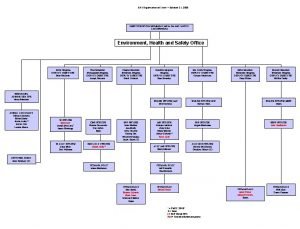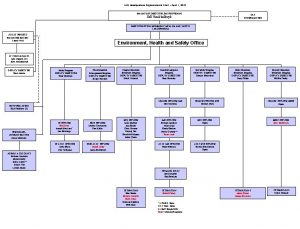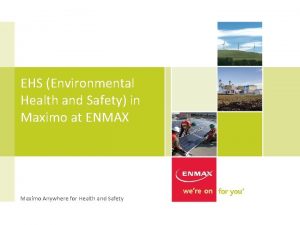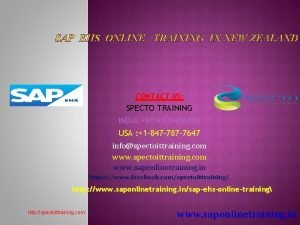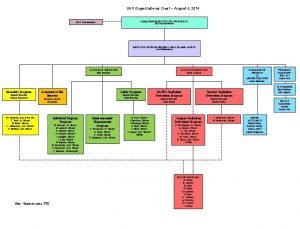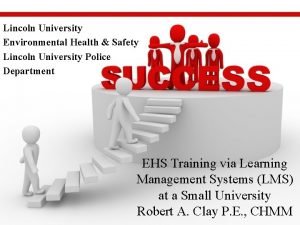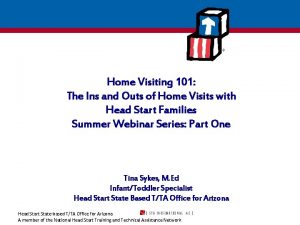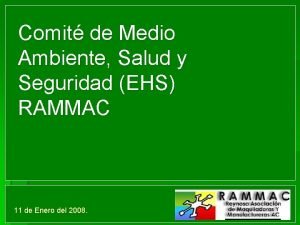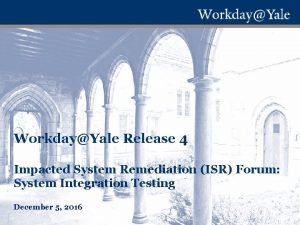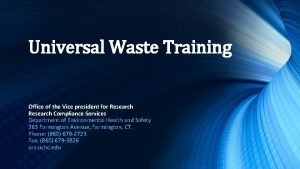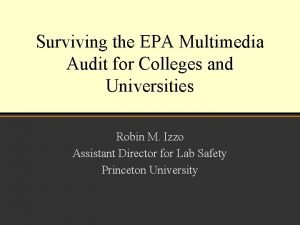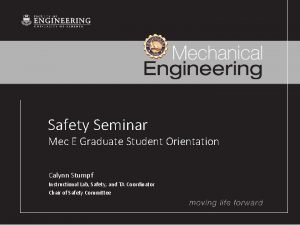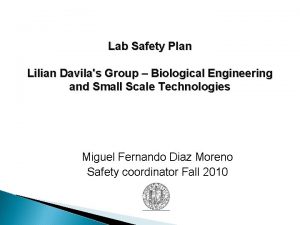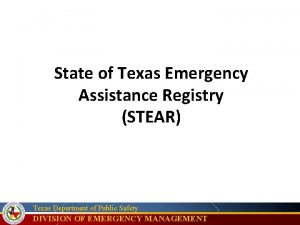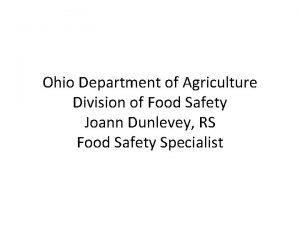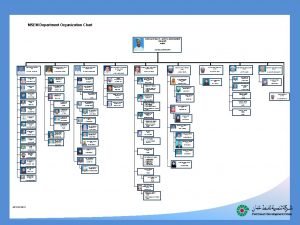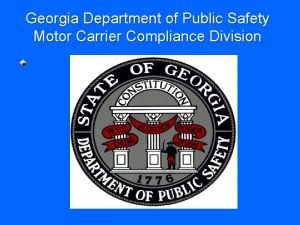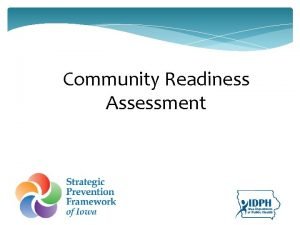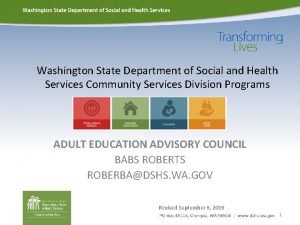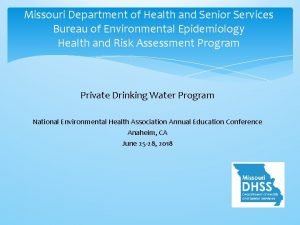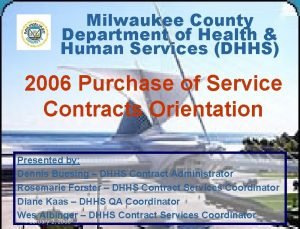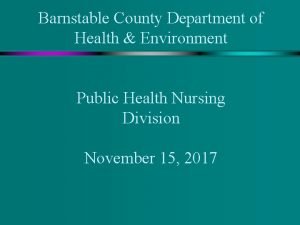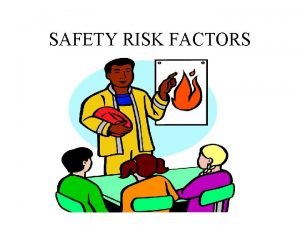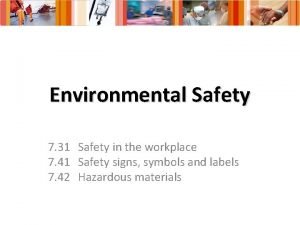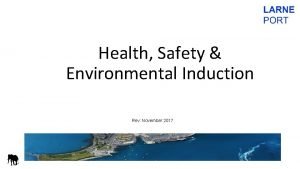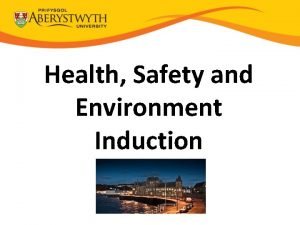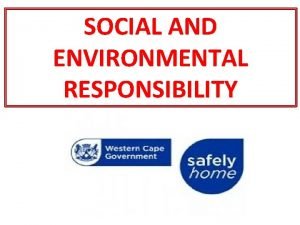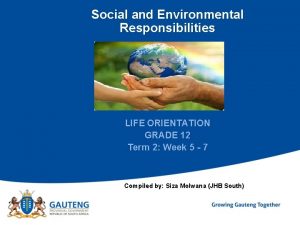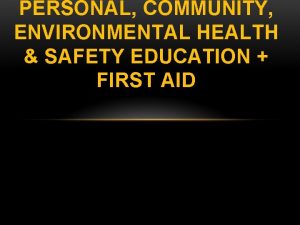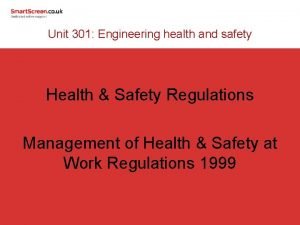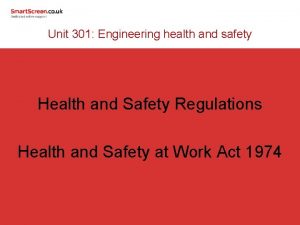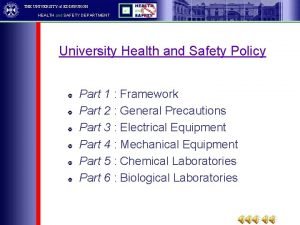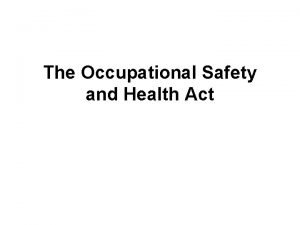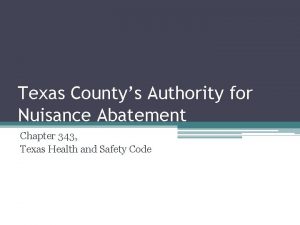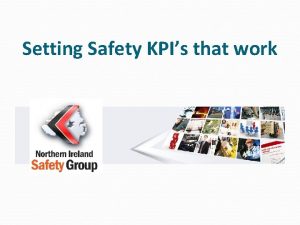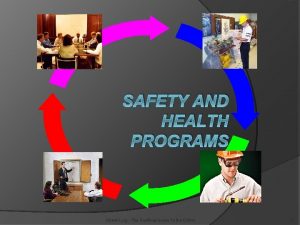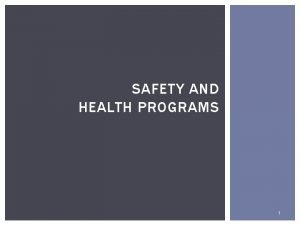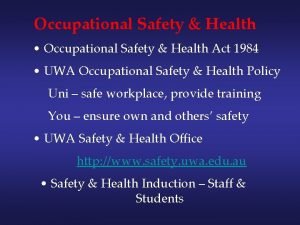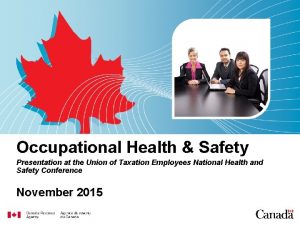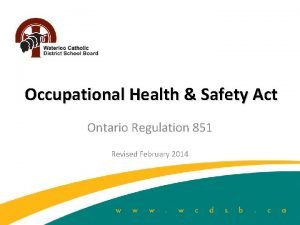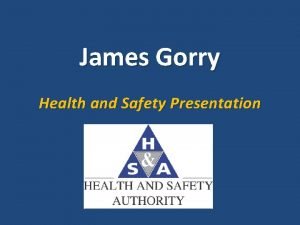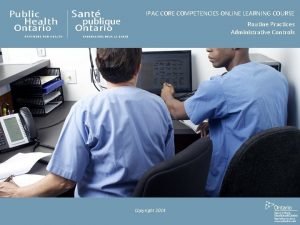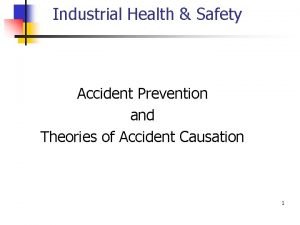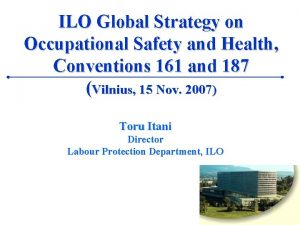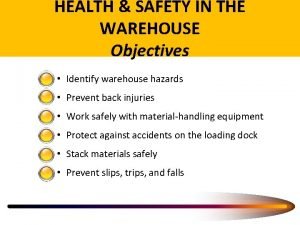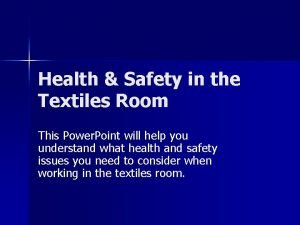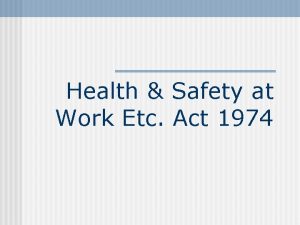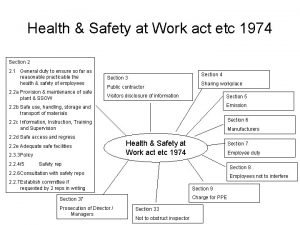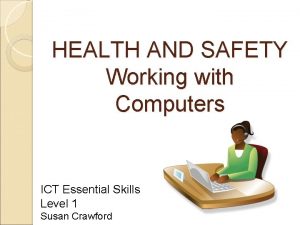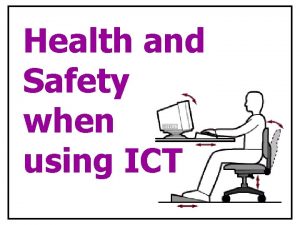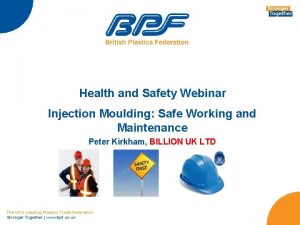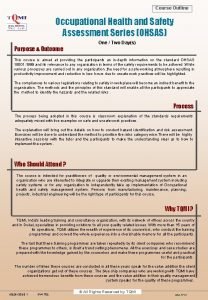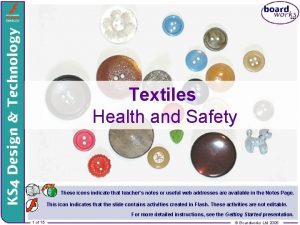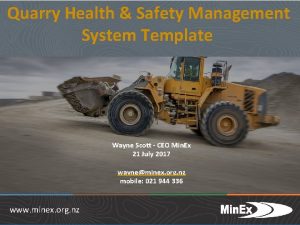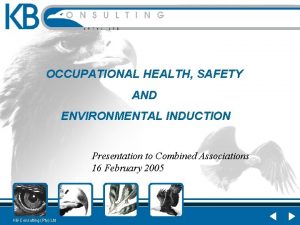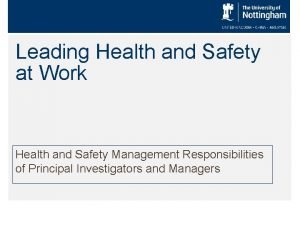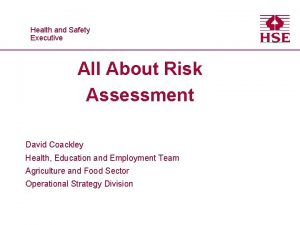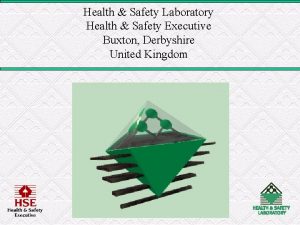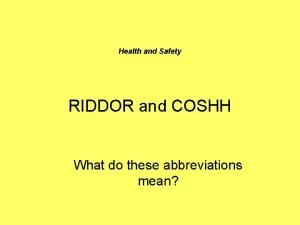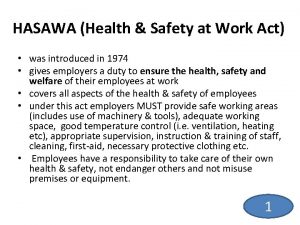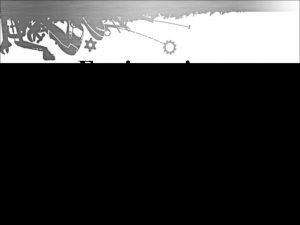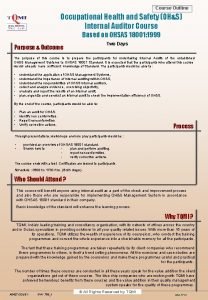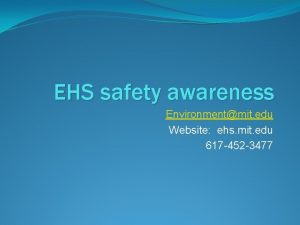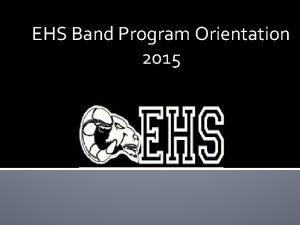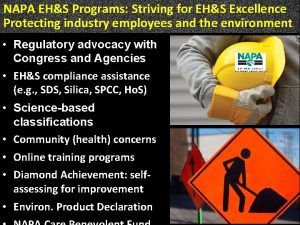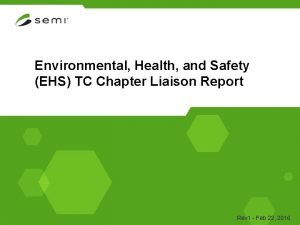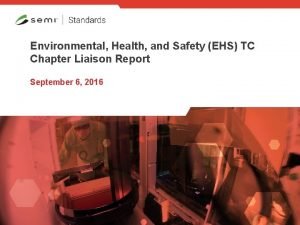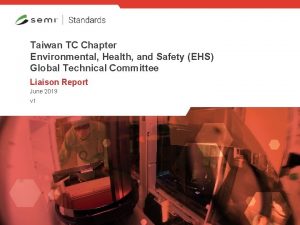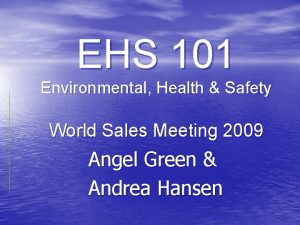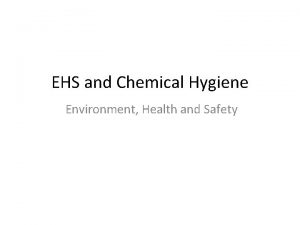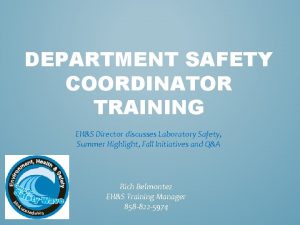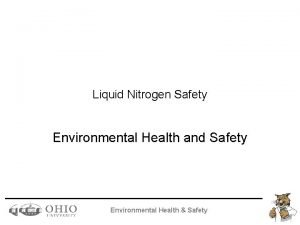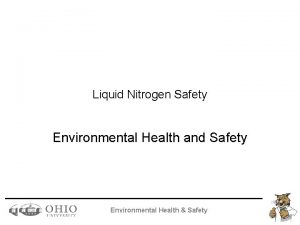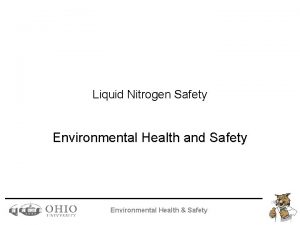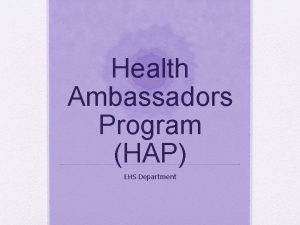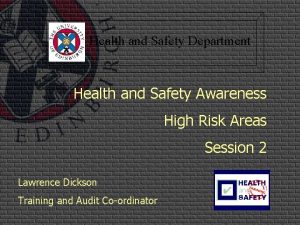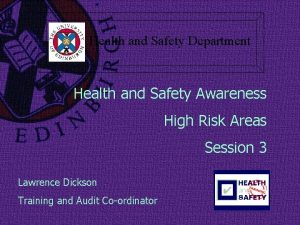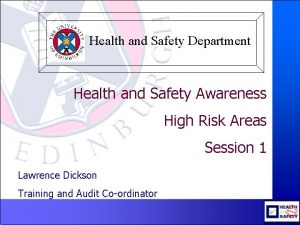Environmental Health Safety EHS Department Environmental Health and








































































































- Slides: 104

Environmental Health & Safety EHS Department Environmental Health and Safety Director Environmental Health Manager Environmental Health and Safety Assistant

Hazard Communication Standard YOUR RIGHT - TO – KNOW and UNDERSTAND Required by OSHA Title 29 CFR 1910. 1200

Hazard Communication Company Policy To comply with OSHA and help protect Jay Industries employees EHS Dept. will update plan as necessary Copies of this program and/or (M)SDS’s can be obtained from any Jay Ind. Computer

Hazard Communication List of Hazardous Chemicals List of all chemicals used in all processes of the plants List is indexed by division and by manufacturers name or the product name List is available to anyone with access to a Jay Ind. Computer.

Hazard Communication Safety Data Sheets (SDS) Provides you with specific information on the chemicals that you use • Name of chemical & the manufacturer • Address and phone # of the manufacturer • The hazards associated with the chemical • Steps to take in case of exposure, fire, or a spill

Hazard Communication Labels All chemicals in the plant must be labeled with at least the name of the chemical & its associated hazards If you ever come across a container with a chemical in it that is not labeled, report it immediately to a supervisor or manager

Hazard Communication Non-routine Task When you are required to perform hazardous non-routine tasks contact your supervisor for specialized training that will advise you regarding the hazardous chemicals to which you might be exposed

Hazard Communication Training All employees will receive training when there is potential exposure to hazardous chemicals from their supervisors If you ever feel that your training is insufficient to perform your duties, feel free to contact your supervisor or the EHS Department

Hazard Communication Contractor Employees Anyone that works on the behalf of Jay Industries that is not a full time employee will receive the same OJT training as the full time employee They will also be made aware of all policies in regards to chemicals that they use or emergency situations that may arise

Hazard Communication Additional Information All employees, or their representatives, can obtain further information on this written program, Hazard Communication Standard 29 CFR 1910. 1200, applicable SDS’s and chemical information lists through the EHS Department or any supervisor with computer access to the Jay Industries, Inc. intranet home page.

Hazard Communication Questions

Emergency Action Plan

Alarms Our alarm system is our telephone paging system All employees should listen to the intercom and follow directions Emergency requiring evacuation When detected notify supervisor at once Tornado watch Weather stations are monitored for conditions

Evacuation Listen to paging system & follow directions Listen to instructions as to where to go and what to do Exit by moving away from emergency to the nearest exit Find and stay with those you work with Once outside, never re-enter for any reason

Tornado Watch Weather will be monitored by radio or internet Warning If appropriate, outside watch will be posted Senior supervisor will determine whether to take shelter

Taking shelter Employee’s calmly take shelter All restroom areas, rooms in lower levels, or offices without windows Employee’s are not to leave until all clear is given

FIRE DRILL Listen for all announcements made over the PA system and follow the instructions. Turn off all the equipment you are operating before leaving. Evacuate the building by going away from the fire to the next available EXIT. Once outside, find those you work with and stay together so your supervisor or line leader can get an accurate attendance. Stay away from propane and CNG storage and refueling areas, electric sub stations and paint and chemical storage areas. DO NOT RE-ENTER THE BUILDING OR LEAVE THE AREA UNTIL YOU ARE NOTIFIED TO DO SO. TORNADO DRILL Listen for all announcements made over the PA system and follow the instructions. When a tornado watch is posted. Supervisors will monitor local radio status for the latest weather information. When a tornado warning is posted. Supervisors will post an out side observer to monitor area conditions. When a tornado is sited in the area. All employees will be advised to go to the nearest tornado shelter, restroom or office designated as a shelter. Stay away from all windows. Do not leave the area until you are notified to do so.

Emergency Action Plan Questions

29 CFR 1910. 1030 Bloodborne Pathogens

Bloodborne Pathogens Goal Eliminate or Minimize Employee Exposure to Bloodborne Pathogens at work

Purpose of Training Employees will learn about: • Bloodborne diseases • How to prevent exposure • How to handle possible exposure • Who is affected the most • Hepatitis B Vaccine • Our plan for prevention and protection

Could You Contract a Bloodborne Disease at Work? Administering first aid? Cleaning the restrooms? Using a tool covered with dried blood? A co-worker sneezes on you? Working in a sewer drain or manhole? Cleaning up after an accident? 10, 000 employees a year get a bloodborne disease at work.

Occupational Exposure Are you at Risk? Janitorial Staff – may clean up blood or OPIM Maintenance Staff – may clean up a machine after an injury First Aid Responders – any Jay Employee who is trained to administer First Aid and CPR in case of an accident or injury

Terms - Blood • Human Blood components, and products made from blood

Terms – Other Potentially Infectious Material (OPIM) OPIM • Semen, Vaginal Secretions • Amniotic Fluid, Cerebrospinal Fluid, Synovial Fluid • Pleural Fluid, Saliva, Sweat, Vomit, Urine • Skin, tissue, cell cultures • Other bodily fluids

Terms – Bloodborne Pathogens Microorganisms (germs) present in blood or other body fluids These germs can cause serious diseases

Terms – Exposure Incident • A specific eye, mouth, mucous membrane, or non-intact skin contact with blood or OPIM that results from the performance of work by an employee.

Terms – Universal Precautions • All potentially infections materials must be handled as if it contains bloodborne pathogens. • Proper work practice controls, engineering controls, and PPE must be used to prevent further contamination and exposure.

Common Bloodborne Pathogens Common bloodborne pathogens include: Human Immunodeficiency Virus (HIV) Hepatitis B (HBV) Hepatitis C (HCV) Hepatitis A (HAV) Also includes: Syphilis-Malaria-Brucellosis

Human Immunodeficiency Virus (HIV) HIV is the virus that leads to AIDS is the Acquired Immune Deficiency Syndrome HIV depletes the immune system so it can no longer fight diseases HIV is life threatening Currently there is NO VACCINE against HIV

HIV Facts HIV is not as infectious as Hepatitis B because there are not as many virus particles present in bodily fluids 1 teaspoon of blood contains about 15 HIV particles HIV is more fragile that Hepatitis B and can be easily destroyed on surfaces outside the body

Hepatitis B (HBV) HBV can live on surfaces at room temperature for up to 10 days, even if blood is dried It is smaller and more common than HIV In 1 tsp of blood, there can be up to one billion (1, 000, 000) HBV particles There are 1 to 1. 4 million chronic carriers in USA (according to CDC)

More on Hepatitis B Can lead to Cirrhosis, Liver Disease and Liver Cancer HBV is the most common form of Hepatitis 300, 000 new cases per year, with 10, 000 due to work exposure Recovery is good if properly diagnosed It is easier to catch than HIV Symptoms include jaundice, fatigue, abdominal pain, loss of appetite, intermittent nausea and vomiting. VACCINATION has been available since 1982

Hepatitis C (HCV) Hepatitis C is the most common chronic bloodborne infection in the United States According to the CDC, there are 2. 7 to 3. 9 million people with Hepatitis C Symptoms include: jaundice, fatigue, abdominal pain, loss of appetite, intermittent nausea, vomiting May lead to chronic liver disease and death There is NO VACCINE to prevent HCV

Hepatitis A (HAV) Contracted through contaminated food or drinking water which contains infected fecal matter There is NO VACCINE available to prevent HAV

Healthy Liver

HBV Infected Liver

Potential Transmission Contact with another person’s blood or other body fluid Mucous membranes: eyes, mouth, nose Non-intact skin Contaminated sharps/needles

Potential Exposure Industrial accident Administering first aid Post-accident cleanup Janitorial or maintenance work

Jay Industries, Inc. Exposure Control Plan (ECP) Potential exposure determination Safe work practices Decontamination Selecting and using PPE Handling biowaste Labels and signs Training requirements Recordkeeping requirements

Exposure Control Plan Our plan is located on Jay Industries, Inc. intranet home page (green screen) Go to EHS tab on right side Open Plans and Procedures tab Bloodborne Pathogens tab

Who Must be Trained? All employees with occupational exposure to blood or other potentially infectious material (OPIM) Employees who are trained in First Aid and CPR Employees who may clean up an accident, such as janitors or maintenance

How often is BBP training required? All employees receive BBP training in Orientation Employees who are trained in First Aid and CPR must have initial class and an annual refresher course Employees who clean up an accident, such as janitorial and maintenance, must have initial class and an annual refresher course

Universal Precautions Treat all blood and bodily fluids as if they are contaminated Proper cleanup and decontamination

Reminder: These are Potentially Infectious Body Fluids Blood Saliva, vomit, urine Semen or vaginal secretions Skin, tissue, cell cultures Other body fluids Sometimes fluids are mixed and it is difficult to determine what they are – all should be considered potentially infectious materials.

Engineering Controls Used needles must be disposed of in a Sharps containers are red plastic jugs found near main restrooms or large first aid cabinets Proper disposal prevents used needle sticks Contact EHS if the Sharps container is full and needs replaced.

Personal Protective Equipment Available at NO cost Found in Bloodborne Pathogen (BBP) kits near large First Aid cabinets Once used, put all contaminated items in red biohazard bag If kit is used, notify EHS for replacement BBP kit contains: Masks Gowns Gloves Safety glasses Shoe covers Hand wipes Red biohazard bag

Protective Equipment Bleeding control – latex gloves Spurting blood – latex gloves, protective clothing (gown), respiratory mask, eye/face protection (goggles or glasses) Post-accident cleanup – latex gloves Janitorial work – latex gloves

Remove gloves safely without spreading germs 1. • Grasp the palm of one glove near your wrist. • Carefully pull the glove off. 3. • Pull the glove until it comes off inside out. • The first glove should end up inside the glove you just took off. • Dispose of the gloves safely. 2. • Hold the glove in the palm of the stillgloved hand. • Slip 2 fingers under the wrist of the remaining glove. 4. • Always wash your hands after removing gloves. Gloves can have holes in them that are too small to be seen.

Safe Work Practices Remove contaminated PPE or clothing as soon as possible Clean and disinfect contaminated equipment and work surfaces Thoroughly wash up immediately after exposure Properly dispose of contaminated items in a red biohazard bag Call EHS for pick up and disposal of red biohazard bag

First Aid Responders If you get blood on you: Wash it off as soon as possible Use soap and water to wash Immediately flush your eyes with running water at a sink or eyewash station Report the incident to your supervisor

First Aid Precautions Protect yourself before offering assistance Wear clean, leak-proof disposable gloves Be aware of your own cuts or broken skin Help a co-worker to stop their own bleeding If blood is spraying, wear goggles or a mask Treat all blood or body fluids as though they are infected Be Careful! Offer comfort while awaiting responders

Housekeeping Precautions Wash hands as soon as possible after contamination and removing gloves No food or drink in clean-up area Clean and decontaminate equipment and surfaces that touch potentially infected materials Do not pick up broken glass or items with your hands, use a broom and dustpan Do not handle items such as pens and door handles while wearing contaminated gloves

Housekeeping items in BBP kit Fluid solidifier Disinfectant spray Pick up scoop and scraper Paper Towels Red Biohazard bags Antimicrobial hand wipes Gloves SDS sheet on contents

Decontamination Wear protective gloves Disinfectant/cleaner provided in bodily fluid disposal kit Or, a solution of ¼ cup bleach per gallon of water Properly dispose of contaminated PPE, towels, and rags in red biohazard bag DO NOT THROW CONTAMINATED MATERIALS IN THE TRASH CAN.

How do I clean up safely? Wear protective gloves Disinfect using solution in kit or ¼ C household bleach per one gallon water If fluids are dry: Spray with disinfectant; wipe dry with paper towel If fluids are wet: Place paper towel or absorbent material over fluid to soak it up Then spray the area with disinfectant; wipe dry Put all contaminated materials in a red biohazard bag

Exposure Incident A specific incident with contact with blood or OPIM If there are no infiltration of mucous membranes or open skin surfaces, it is not considered an exposure incident Report all incidents involving blood or bodily fluids to supervisor Supervisor will complete an accident/incident report

Exposure Incident A specific incident with contact with blood or OPIM If there are no infiltration of mucous membranes or open skin surfaces, it is not considered an exposure incident Report all incidents involving blood or bodily fluids to supervisor Supervisor will complete an accident/incident report

Regulated Medical Waste Liquid or semiliquid blood or OPIM Contaminated items that would release blood or OPIM when compressed Contaminated sharps Waste containing blood or OPIM

Regulated Medical Waste Contact EHS for pick-up and disposal of regulated waste DO NOT THROW CONTAMINATED MATERIAL IN THE TRASH CAN

Labels and Signs Labels must include the universal biohazard symbol, and the term “Biohazard” must be attached to: • Containers or bags of regulated biohazard waste • Sharps containers used to store, transport, or ship used needles

Biohazard Warning Label must be placed on biohazard red bags and sharps containers

Hepatitis B Vaccination The Hepatitis B Vaccination is offered after training to the following employees of Jay Industries, Inc. : Employees trained to offer First Aid and CPR Janitorial Maintenance

Hepatitis B Vaccine Three part vaccine timed over a period of months Offers protection for Hepatitis B Given by Avita No cost to the employee Employees must contact Human Resources to authorize and schedule the vaccine If vaccine is refused, must sign declination form

Exposure Incident A specific incident of contact with potentially infectious bodily fluid If there are no infiltrations of mucous membranes or open skin surfaces, it is not considered an occupational exposure Report all accidents involving blood to bodily fluids Post-exposure medical evaluations are offered

What to do if exposure occurs? Wash exposed area with soap and hot water Flush splashes to nose, mouth, or skin with water Irrigate eyes with water or saline Report the incident to a supervisor Complete an Accident/Incident report Contact Human Resources for direction

Post-exposure follow-up Jay Industries, Inc. Human Resources will: – Direct employee to Work. Able or Ohio. Health Med. Central – Provide documentation of route of exposure and how it occurred via the Accident/Incident form completed by supervisor – Identify and obtain written consent from source individual for follow-up testing

Post-exposure follow-up Health Care Provider will: Obtain sample from source individual and exposed employee and test blood as soon as possible after incident Advise exposed employee on possible vaccination and treatment options Provide written opinion of findings to employer and copy to employee within 15 days of evaluation

Recordkeeping Medical records include: Hepatitis B vaccination status Post-exposure evaluation and follow-up results Training records include: Training dates Contents of the training Name and qualifications of trainer

Administration Environmental, Health and Safety (EHS) Department is the keeper of the plan and reviews it every year Human Resources (HR) can be contacted about the Hepatitis B vaccine Questions? Contact EHS or HR

Summary Bloodborne Pathogen rules are in place to protect your health and safety. Follow the rules to reduce your risk of disease. Failure to follow the rules is a risk that you should not take.

Any Questions? Issues? Problems?

29 CFR 1910. 39 Fire Prevention Plan

Fire Prevention Plan Management Designed to ensure all reasonable steps are taken to preserve life and property from fire. Each employee can help prevent fires by keeping his/her work area clean and free of trash and spills.

Fire Prevention Plan Management Procedures are established for reporting fires and other incidents. Any fire, no matter how small, must be reported to the supervisor so equipment used can be inspected and/or replaced. Fire drills are held at least annually.

Fire Prevention Plan List of Major Fire Hazards Fuel gases – acetylene, propane, nat. gas Flammable paints, thinners, and reducers Combustible paints and related products Oil and/or solvent soaked rags Paper, cardboard and combustible trash Oils, fluids and lubricants

Fire Prevention Plan Potential Ignition Sources Open flames – welding, lighters, cigarettes Electric motors – air compressors, tools Spark producing equipment Overheated electrical equipment Hot engine parts – exhaust or muffler

Fire Prevention Plan Housekeeping, Maintenance & Storage Smoking is prohibited in the plant area Flammable liquids, gases & aerosols must be stored in designated areas or containers Oil & solvent soaked rags must be placed in their designated areas Combustible material such as paper, cardboard must never be placed near heat producing devices or machines

Fire Prevention Plan Housekeeping, Maintenance & Storage All spills must be cleaned up using proper procedures by trained personnel Any leaking tanks or barrels must be reported immediately for prompt repair Faulty machinery or equipment must also be reported immediately Only authorized personnel may operate or repair machinery or equipment

Fire Prevention Plan Housekeeping, Maintenance & Storage Monthly inspections of all fire extinguishers are performed by the EHS department All fire protection devices are serviced and maintained on an annual basis All heat producing equipment are serviced annually or as needed

Fire Prevention Plan Information and Training EHS department may be contacted with any questions regarding this plan This plan will be reviewed during new employee orientation, whenever major changes are made to the plan Whenever the employee’s responsibilities change under the plan

Fire Prevention Plan Questions

29 CFR 1910. 132 Personal Protective Equipment

Personal Protective Equipment Safety Glasses Required at all metals divisions Required in certain processes at plastics divisions • When blowing off parts using compressed air • While using saws and lathes in the tool room • Whenever operation is labeled to use safety glasses (Kolene)

Personal Protective Equipment Hearing protection Although there are no areas at any division that require the use of hearing protection, certain tasks and operations are labeled that hearing protection is required. Please use hearing protection while performing these tasks.

Personal Protective Equipment Hearing Protection Hearing protection is made available to anyone that feels they are in need of protection from noise. Prolonged exposure generally causes permanent damage

Personal Protective Equipment Hearing Protection Noise is unwanted/unpleasant sound that may have a negative effect depending on: • loudness/frequency • duration of exposure • how old/healthy person is

Hearing protection makes common sense You are ultimately responsible for your own hearing You have the most to lose if you suffer hearing loss Make sure earplugs fit properly 6 a

Personal Protective Equipment Personal protective clothes Wear whenever required Respirator use There are no tasks that require the use of a respirator. If you need a respirator, notify your supervisor so testing and training can be scheduled. You must have these tests before a respirator will be issued.

Personal Protective Equipment If PPE is a requirement for part of your job, you will be notified and trained on the proper use during OJT training.

Personal Protective Equipment Questions

General Safety Training If you ever have a safety concern, notify your supervisor immediately Report all accidents, injuries and near misses to your supervisor ASAP If you have to evacuate the building, congregate with your department outside in an area away from danger & ensure your supervisor knows you are out of the building

General Safety Training Hazardous weather shelters are located at all divisions. In the event of severe weather go to one of these areas and wait for instructions from your supervisor. If you have any questions concerning your health and safety, don’t hesitate to contact the EHS Department.

ISO 14001

Reasons for Certification Required by your customer Competitive edge in the global marketplace Cost savings thru pollution prevention Improved regulatory compliance Reduction in environmental liability

Major Elements of the Standard Continual Improvement Environmental Aspects Environmental Impacts Environmental Objectives & Targets Environmental Policy

Continual Improvement A process of enhancing the Environmental Management System to achieve improvement in overall environmental performances in line with the organization’s Environmental Policy.

Environmental Aspect Element of an organization’s activities or products or services that can interact with the environment.

Environmental Impact Any change to the environment whether adverse or beneficial, wholly or partially resulting from an organization’s environmental aspects.

Environmental Objective & Targets Environmental goals that the company sets for itself to achieve, with specific time frames to achieve them by.

Written Environmental Policy Jay Industries, Inc. is dedicated to preserving and improving the environment.

Other questions during audits How does your job affect the environment? What does your department do to help the environment? Who do you go to if you have an environmental or safety question? Where do you go in case of a fire? Where do you go in case of a tornado?

ISO 14001 Questions

THE END!!
 Osu ehs training
Osu ehs training Environmental health and safety uf
Environmental health and safety uf Ehs oregon state
Ehs oregon state Wsu environmental health and safety
Wsu environmental health and safety Penn state environmental health and safety
Penn state environmental health and safety San diego department of environmental health
San diego department of environmental health Esh environmental safety health
Esh environmental safety health Louisiana department of health and hospitals licensing
Louisiana department of health and hospitals licensing Wa department of water and environmental regulation
Wa department of water and environmental regulation Undss logo
Undss logo Job safety and environmental analysis
Job safety and environmental analysis Nyc department of environmental protection
Nyc department of environmental protection Louisiana department of environmental quality ldeq
Louisiana department of environmental quality ldeq Sacramento county environmental management
Sacramento county environmental management St lucie county environmental resources department
St lucie county environmental resources department Ehs mit
Ehs mit Sap ehs training
Sap ehs training Mit ehs
Mit ehs Eh&s ucsb
Eh&s ucsb Ehs organization chart
Ehs organization chart Ehs organization chart
Ehs organization chart Ehs organization chart
Ehs organization chart Maximo anywhere training
Maximo anywhere training Yale sciquest
Yale sciquest Sap ehs training
Sap ehs training Ehs organization chart
Ehs organization chart Lincoln university police
Lincoln university police Huawei ehs exam answers
Huawei ehs exam answers Ehs flexisched
Ehs flexisched Mc ehs
Mc ehs Yale ehs integrator
Yale ehs integrator Ncsu ehs
Ncsu ehs Ehs scorecard
Ehs scorecard Spfonline
Spfonline Ehs awareness training
Ehs awareness training Uconn ehs waste pickup
Uconn ehs waste pickup Multimedia compliance audit
Multimedia compliance audit Ehs ucf
Ehs ucf Ualberta ehs
Ualberta ehs Lab safety plan unc
Lab safety plan unc členové ehs
členové ehs Texas department of public safety
Texas department of public safety Virginia department of agriculture food safety
Virginia department of agriculture food safety Ohio cottage food law label
Ohio cottage food law label Safety department organization chart
Safety department organization chart Georgia motor carrier compliance division
Georgia motor carrier compliance division Wireless health
Wireless health Iowa department of health and human services
Iowa department of health and human services Washington state department of social and health services
Washington state department of social and health services Department of health and senior services missouri
Department of health and senior services missouri Milwaukee county health and human services
Milwaukee county health and human services Maine department of health and human services
Maine department of health and human services Barnstable county department of health and environment
Barnstable county department of health and environment Portal of entry
Portal of entry Environmental safety
Environmental safety No work prior to safety/environmental induction sign
No work prior to safety/environmental induction sign Aberlearn
Aberlearn Ecdis safety settings
Ecdis safety settings Qbs safety care
Qbs safety care Process safety vs personal safety
Process safety vs personal safety Safety assessment for ind safety reporting
Safety assessment for ind safety reporting Basic safety orientation
Basic safety orientation Basic safety construction site safety orientation
Basic safety construction site safety orientation Health social and environmental responsibility
Health social and environmental responsibility Topic social and environmental responsibility
Topic social and environmental responsibility Health and environmental sciences institute
Health and environmental sciences institute Personal community and environmental health
Personal community and environmental health Unit 301
Unit 301 Health and safety regulations in engineering
Health and safety regulations in engineering Health and safety edinburgh
Health and safety edinburgh Williams-steiger occupational safety and health act of 1970
Williams-steiger occupational safety and health act of 1970 Care certificate answers
Care certificate answers Texas health and safety code 343
Texas health and safety code 343 Six pack health and safety regulations
Six pack health and safety regulations Health and safety kpis
Health and safety kpis Oshax
Oshax Benefits of a safety and health program
Benefits of a safety and health program Health and safety in hrm
Health and safety in hrm Occupational safety and health act 1984
Occupational safety and health act 1984 Occupational health and safety presentation
Occupational health and safety presentation Health and safety act ontario
Health and safety act ontario James gorry
James gorry Ipac core competencies
Ipac core competencies Human factors theory
Human factors theory Global strategy on occupational safety and health
Global strategy on occupational safety and health Warehousing health and safety
Warehousing health and safety Safety in the textiles room
Safety in the textiles room Health and safety at work act 1974 section 7
Health and safety at work act 1974 section 7 Health and safety at work act
Health and safety at work act Health and safety on computers
Health and safety on computers Health and safety ict
Health and safety ict Mould loading and unloading procedure
Mould loading and unloading procedure Occupational health and safety course outline
Occupational health and safety course outline Textiles health and safety
Textiles health and safety Food safety management system template
Food safety management system template Health and safety induction presentation
Health and safety induction presentation Leading health and safety at work
Leading health and safety at work Health and safety risk assessment template
Health and safety risk assessment template Health and safety buxton
Health and safety buxton Meaning of coshh and riddor
Meaning of coshh and riddor Health and safety in performing arts
Health and safety in performing arts Health and safety in performing arts
Health and safety in performing arts What is the hasawa
What is the hasawa Six pack regulations
Six pack regulations Occupational health and safety course outline
Occupational health and safety course outline
